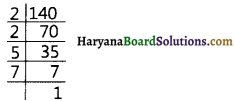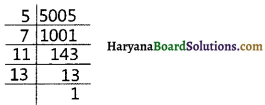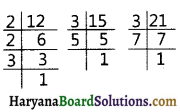Haryana State Board HBSE 10th Class Maths Solutions Chapter 1 Real Numbers Ex 1.2 Textbook Exercise Questions and Answers.
Haryana Board 10th Class Maths Solutions Chapter 1 Real Numbers Exercise 1.2
Question 1.
Express each number as a product of its prime factors :
(i) 140
(ii) 156
(iii) 3825
(iv) 5005
(v) 7429
Solution :
(i) 140

140 = 2 × 2 × 5 × 7 2 70
= 22 × 5 × 7
(ii) 156

156 = 2 × 2 × 3 × 13
= 22 × 3 × 13
(iii) 3825

3825 = 3 × 3 × 5 × 5 × 17
= 32 × 52 × 17
![]()
(iv) 5005

5005 = 5 × 7 × 11 × 13
(v) 7429

7429 = 17 × 19 × 23
![]()
Question 2.
Find the LCM and HCF of the following pairs of integers and verify that LCM × HCF = product of the two numbers:
(i) 26 and 91
(ii) 510 and 92
(iii) 336 and 54
Solution:
(i) 26 and 91

26 = 2 × 13
91 = 7 × 13
HCF (26, 91) = 13
(product of the smallest power of each common prime factor in the numbers).
LCM (26, 91) = 2 × 7 × 13 = 182
(product of the greatest power of each prime factor in the numbers).
LCM (26, 91) × HCF (26,91) = 182 × 13 = 2366
Product of two numbers = 26 × 91 = 2366
Hence, LCM × HCF = product of two numbers
![]()
(ii) 510 and 92

510 = 2 × 3 × 5 × 17
92 = 2 × 2 × 23
= 22 × 23
HCF (510, 92) = 2
LCM (510, 92) = 22 × 3 × 5 × 17 × 23 = 23460
LCM (510, 92) × HCF (510, 92) = 23460 × 2 = 46920.
Product of two numbers = 510 × 92 = 46920
(iii) 336 and 54

336 = 2 × 2 × 2 × 2 × 3 × 7
= 24 × 3 × 7
54 = 2 × 3 × 3 × 3
= 2 × 33
HCF (336, 54) = 2 × 3 = 6
LCM (336, 54) = 24 × 33 × 7 = 3024
LCM (336, 54) × HCF (336, 54)= 3024 × 6 = 18144
Product of two numbers = 336 × 54 = 18144
Hence, LCM × HCF = Product of the two numbers.
![]()
Question 3.
Find the LCM and HCF of the following integers by applying the prime factorization method.
(i) 12, 15 and 21
(ii) 17, 23 and 29
(iii) 8, 9, and 25.
Solution :
(i) 12, 15 and 21

12 = 2 × 2 × 3
= 22 × 3
15 = 3 × 5
21 = 3 × 7
LCM (12, 15, 21) = 22 × 3 × 5 × 7 = 420.
HCF (12, 15, 21) = 3
∴ LCM = 420 and HCF = 3.
(ii) 17, 23 and 29
17 = 1 × 17
23 = 1 × 23
29 = 1 × 29
LCM (17, 23, 29) = 17 × 23 × 29 = 11339
HCF (17, 23, 29) = 1
∴ LCM = 11339, HCF = 1
(iii) 8, 9 and 25

8 = 2 × 2 × 2 = 23
9 = 3 × 3 = 32
25 = 5 × 5 = 52
LCM (8, 9, 25) = 23 × 32 × 52 = 1800
HCF (8, 9, 25) = 1
∴ LCM = 1800, HCF = 1.
![]()
Question 4.
Given that HCF (306, 657) LCM (306, 657).
HCF (306, 657) = 9
Numbers = 306, 657
LCM (306, 657) = ?
We know that,
Solution:
LCM = Product of two numbers / HCF
= \(\frac{306 \times 657}{9}\)
= 34 × 657 = 22338
Question 5.
Check whether 6n can end with the digit 0 for any natural number n.
Solution :
If the number 6n ends with the digit 0, then it is divisible by 5, hence, it has 5 as a prime factor.
But 6n = (2 × 3)n
= 2n × 3n
i.e. 6n contain prime 2 and 3 factors.
Uniqueness of fundamental theorem of arithmetic guarantees that there are no other primes in the factorization of 6n.
⇒ 6n does not contain prime 5.
Hence, 6n cannot end with the digit 0 for any natural number n.
![]()
Question 6.
Explain why 7 × 11 × 13 + 13 and 7 × 6 × 5 × 4 × 3 × 2 × 1 + 5 are composite numbers.
Solution :
Since 7 × 11 × 13 + 13
= (7 × 11 + 1) × 13
= (77 + 1) × 13
= 78 × 13
= 2 × 3× 13 × 13.
It is the product of prime. By fundamental theorem of arithmetic 7 × 11 × 13 + 13 is a composite number.
Again 7 × 6 × 5 × 4 × 3 × 2 × 1 + 5 = (7 × 6 × 4 × 3 × 2 × 1 + 1) × 5
= (1008 + 1) × 5 = 1009 × 5
Which is the product of primes. By the fundamental theorem of arithmetic 7 × 6 × 5 × 4 × 3 × 2 × 1 + 5 is composite number.
Question 7.
There is a circular path around a sports field, Sonia takes 18 minutes to drive one round of the field, while Ravi takes 12 minutes for the same. Suppose they both start at the same point and at the same time, and go in the same direction. After how many minutes will they meet again at the starting point ?
Solution :
The time they meet again at the starting point = LCM of 18 and 12 minutes.

18 = 2 × 3 × 3
= 2 × 32
12 = 2 × 2 × 3
= 22 × 3
Hence, they will meet again at the starting point after 36 minutes.